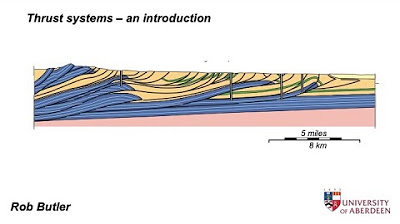Linked thrust systems
Summary
TLDRThis presentation explores the development and evolution of linked thrust systems, particularly in the foothills of the Canadian Cordillera in Alberta. It examines how complex thrust structures migrate, transfer displacement, and form duplexes. Key concepts include the role of detachment horizons, floor and roof thrusts, and the formation of thrust slices or 'horses.' The presentation contrasts buried thrust systems with emergent systems that interact with surface processes, using examples from the Northern Apennines and the Himalayas to illustrate how these systems impact geological structures and surface features.
Takeaways
- 🗻 Linked thrust systems explain how complex thrust systems evolve and migrate.
- 🔄 These systems transfer displacement, which leads to the development of intricate structures.
- 📏 Buried thrust systems differ from those that interact with the Earth's surface, particularly in how they deform.
- 🔧 The 'roof thrust' acts as a cap over stacked thrust units, controlling the system's development.
- 🔗 The system uses easy slip horizons, transferring motion and isolating thrust slices beneath the thrust sheet.
- 🏗 A duplex structure is formed with a roof thrust at the top, a floor thrust at the bottom, and slices (horses) in between.
- 📊 Multiple detachment horizons are active, particularly in Alberta, where they play a key role in displacement.
- 🚚 Thrust slices form in a piggyback sequence, with younger thrusts carrying older ones forward.
- 🌍 Emergent thrust systems, like those in the Himalayas and Northern Apennines, directly interact with surface processes.
- 🛠 Displacements in buried systems must recombine and ultimately interact with the surface through various thrust connections.
Q & A
What are linked thrust systems, and how do they evolve?
-Linked thrust systems are interconnected networks of thrust faults that evolve over time by transferring displacement and reorganizing through interactions between buried and emergent thrust sheets. They migrate towards the foreland in a piggyback sequence as younger thrusts develop beneath older ones.
What is the role of 'easy slip horizons' in the development of thrust systems?
-Easy slip horizons act as planes of weakness along which slip is transferred during deformation. These horizons allow for the lateral movement of thrust sheets, which bulldoze younger stratigraphic units away, creating buried panels beneath the thrust sheet.
What is a duplex in the context of thrust systems?
-A duplex is a structural configuration where multiple thrust slices (called horses) are stacked between a roof thrust and a floor thrust. Each thrust slice is bounded entirely by thrusts and develops as displacement transfers between slip surfaces.
What are the key components of a duplex structure?
-The key components of a duplex structure include the roof thrust (the upper bounding thrust), the floor thrust (the lower bounding thrust), and the imbricated thrusts that separate the individual slices, called horses.
How do thrust systems migrate and evolve in a piggyback sequence?
-Thrust systems evolve in a piggyback sequence when earlier thrusts are progressively carried by younger thrusts that form beneath them. This results in the older thrust sheets being transported towards the foreland by the newer ones, creating a stacked sequence.
What evidence in cross-sections supports the existence of a piggyback sequence?
-In cross-sections, piggyback sequences are identified by folded thrusts and bulged roof thrusts, indicating that lower thrusts have come in from underneath. The deformed thrust sheets, with some tipped downward, provide further evidence.
What distinguishes emergent thrust systems from buried ones?
-Emergent thrust systems interact directly with the Earth's surface, influencing surface processes, while buried thrust systems remain below the surface, combining and recombining through detachment horizons and roof thrusts.
How do emergent thrust systems affect surface processes?
-Emergent thrust systems can significantly impact surface processes by deforming the Earth's surface. For example, they can fold and tilt recent sediments, such as river gravels, as seen in the Salt Range of the Himalayas, where the thrust system deforms river deposits.
What are the detachment horizons mentioned in the Alberta cross-section?
-In the Alberta cross-section, three detachment horizons are active: one at the top of the Devonian, one in the Jurassic Fernie Formation, and another within the Blackstone Formation. These horizons collect and transfer thrust displacement during deformation.
How do thrust systems in the northern Apennines illustrate emergent imbricated fans?
-In the northern Apennines, the strata show thickness variations between thrust sheets, indicating that deposition and structural evolution were controlled by the emergent thrust system. This illustrates how thrust sheets interact with surface processes.
Outlines

This section is available to paid users only. Please upgrade to access this part.
Upgrade NowMindmap

This section is available to paid users only. Please upgrade to access this part.
Upgrade NowKeywords

This section is available to paid users only. Please upgrade to access this part.
Upgrade NowHighlights

This section is available to paid users only. Please upgrade to access this part.
Upgrade NowTranscripts

This section is available to paid users only. Please upgrade to access this part.
Upgrade NowBrowse More Related Video

Thrust systems - an introduction

トランプ関税でカナダは「団結」か「分裂」か…「石油の街」で過熱する“分離独立”論争とは?【TV TOKYO International】

Critical Wedge Theory: a Himalayan example (C8)

Building Applications with AI Agents — Michael Albada, Microsoft

Reverse Thrust - Aircraft Gas Turbine Engines #12

14 ATPL Training Gas Turbine Engines #14 Thrust Augmentation
5.0 / 5 (0 votes)